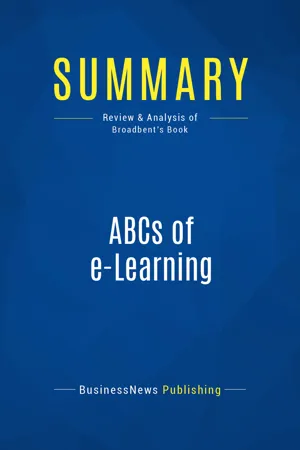
Summary: ABCs of e-Learning
Review and Analysis of Broadbent's Book
- English
- ePUB (mobile friendly)
- Available on iOS & Android
About this book
The must-read summary of Brooke Broadbent's book: `ABCs of e-Learning: Reaping the Benefits and Avoiding the Pitfalls`.
This complete summary of the ideas from Brooke Broadbent's book `ABCs of e-Learning` shows that with computers and the Internet being so widely accessible, the digital space is a perfect vehicle for cost-effective learning. Electronic learning, or e-Learning as it is known, has not been half as successful as it could be. Apart from its wide reach and cost effectiveness, it has many other benefits including its adaptable structure, its interactive nature, its flexibility, and most interestingly the fact that it is non-linear meaning participants can skip material or specify the order in which they learn, something that cannot be tailored in the classroom. Thanks to all these advantages, e-Learning is becoming increasingly popular at all levels of education. This summary helps to dissect the different forms of e-Learning and explains how to plan and roll out successful e-Learning courses with solid, measurable results.
Added-value of this summary:
• Save time
• Understand key concepts
• Increase your business knowledge
To learn more, read `ABCs of e-Learning` and enhance the bottom line by making an organization more productive, saving money, and providing learners with more access to more training.
Frequently asked questions
- Essential is ideal for learners and professionals who enjoy exploring a wide range of subjects. Access the Essential Library with 800,000+ trusted titles and best-sellers across business, personal growth, and the humanities. Includes unlimited reading time and Standard Read Aloud voice.
- Complete: Perfect for advanced learners and researchers needing full, unrestricted access. Unlock 1.4M+ books across hundreds of subjects, including academic and specialized titles. The Complete Plan also includes advanced features like Premium Read Aloud and Research Assistant.
Please note we cannot support devices running on iOS 13 and Android 7 or earlier. Learn more about using the app.
Information
Summary of ABCs Of e-Learning (Brooke Broadbent)
1. An Overview of e-Learning

1. Informal e-learning
- Help each other learn more about their specialist field.
- Find answers to difficult problems.
- Share facts, opinions, ideas and more.
2. Self-paced e-learning
- Multimedia sound and video clips.
- Learning activities, exercises and other content.
- Before-and-after assessment tests to gauge learning.
- Simulations of common problems.
- Activities which build the desired skills and competencies.
- Assignments and other follow-up requirements.
3. Leader-led e-learning
4. Performance support e-learning & tools
- Who is to do the learning?
- Who is available to teach them?
- What level of knowledge about computers is assumed?
- When are the learners going to be available...
Table of contents
- Title page
- Book Presentation
- Summary of ABCs Of e-Learning (Brooke Broadbent)
- About the Summary Publisher
- Copyright